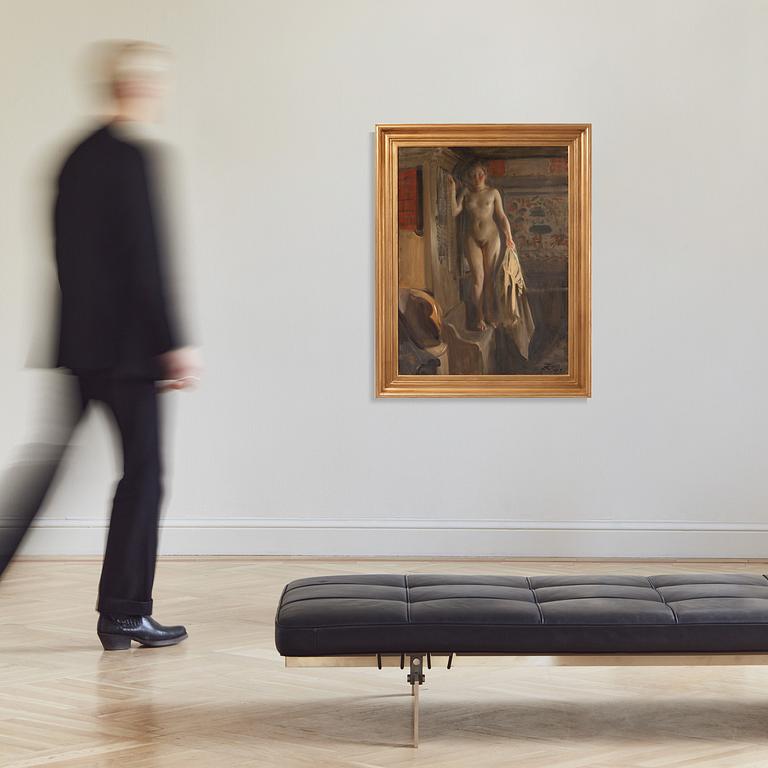Anders Zorn
"Kuvåsängen"
Signed Zorn and dated 1918. Canvas 100 x 75 cm.
Provenance
Earlier in the estate of Anders Zorn, sold by the Zorn collections, Mora.
Fritzes Kungl. Hovbokhandel, Stockholm.
Private Collection.
Exhibitions
Konstföreningen, Stockholm, "Zorns utställning. Till förmån för Röda stjärnan", 18 February - 10 March 1918, cat. no 26.
Liljevalchs konsthall, Stockholm, "Bruno Liljefors - Anders Zorn", 10 April - 25 April 1920, cat. no 87. Titled "Maja".
Liljevalchs konsthall, Stockholm, "Anders Zorn - Minnesutställning", 1 March - 6 April 1924, cat. no 195.
Liljevalchs konsthall, Stockholm, "Zorns samlingar", 5 February - 5 March 1930, cat. no 149.
Literature
Tor Hedberg, ”Anders Zorn. 1860-1893”, SAK, 1923, illustrated p. 133 (pl. 89) and mentioned p. 149.
Gerda Boëthius, ”ZORN. Tecknaren, Målaren, Etsaren, Skulptören”, 1949, listed in the catalog under the year 1918 p. 555.
More information
"Kuvåsängen" from 1918 is an exquisite interior from Zorn's Gammelgård in Gopsmor were Zorn engages in a penetrating study of light and shadow. Daylight, which interacts with the darkness of the composition, enters from the window on the right and illuminates the model's left side where she stands naked on the bench and meets the viewer's gaze.
The motifs from Gopsmor were created with a serious intention. Zorn came from a village with old-fashioned customs and simple conditions. His depictions of rural life were created at a time when industrialism threatened inherited patterns of life, and the paintings took on the character of uncomplicated counter-images to the accelerating development towards "modernity".
Hans Henrik Brummer has spoken of "a deepened emotional content, which in this context can be described as a mild love of the homeland" and continues his argument by stating:
"His pictures from Gopsmor tell of the sensuality of a simple form of life. That he depicted an Arcadian paradise was entirely in accordance with his artistic program. The extensive production from Gopsmor shows great variety and consists largely of popular images'.
Artist
Anders Zorn, born in Mora in 1860, showed artistic talent from a young age. In 1875, he traveled to Stockholm and became a student at the then Slöjdskolan (now Tekniska högskolan) in Stockholm, and shortly after, he joined the Royal Academy of Fine Arts. Initially, Zorn had aspirations of becoming a sculptor, but soon watercolor painting took over, becoming his primary medium until 1887. At the student exhibition in 1880, Zorn had his breakthrough with the watercolor painting "I sorg." The following year, he gained international acclaim as a portrait painter. His watercolor painting reached its pinnacle during this period, and his most famous work from this time is "Vårt dagliga bröd” from 1886. Shortly thereafter, Zorn transitioned to oil painting, which was met with immediate success. Zorn's reputation mainly rested on his portrait art, and he portrayed many notable figures, including presidents. For instance, he created an etching of Theodore Roosevelt. His etchings significantly contributed to his success. In the late 1880s, Zorn began working in the genre that would increasingly become his trademark: nude figures in outdoor settings. He had long been fascinated by the movement of water and the reflections of light on its surface. Now, he added the complexity of placing a model near or in the water, aiming to depict a synthesis between nature and humanity. In 1896, Zorn and his wife moved back to Sweden and settled in Zorngården in Mora. This move sparked a renewed interest in his homeland, which would be reflected in his future paintings. Among the artist's scenes from the Mora region, portraying its local customs and ancient traditions, "Midsommardansen" holds the highest value according to Zorn himself. Today, the painting can be found at the National Museum.
Read more






























































